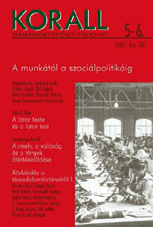A lator teste és a lator test. A bűnösség kultúrája a kora újkori Magyarországon és a büntetés-emlékeztetés problémája
The Thief’s Body and the Rascal Body. The Culture of Guilt in Early Modern Hungary and the problem of Guilt Recalling
Author(s): G. Péter TóthSubject(s): History
Published by: KORALL Társadalomtörténeti Egyesület
Keywords: social history; Hungary; 12-17 centuries; body; torture; Christianity; iconography; public execution; criminal law; György Dózsa
Summary/Abstract: Words like aggression, violence, and violent actions usually carry destructive meanings. People tend to forget their constructive culturally determined meanings. In spite of this, it cannot be argued that aggressive feelings, hatred, anger, verbal aggression, threatening behaviour, assault, giving pain, injuring or ritual killing of men, or the fights of war are all part of our lives like feasts and rituals that keep communities together, or the order of love by different religious ideologies. In the 16th century there was a definitive turn in judging the body in public. It meant that public attention gradually turned to the thieves’ body from the corpse of Christ. The two thieves came down from their crosses, laid down on the dissecting table, or their bodies were torn apart during fights. Rascals became part of scientific cognition. Antisocial public enemy turned to be a hero of the community in the pitaval-literature and historic stories. The conserved and stuffed body of the robbers and killers were displayed at the first museums of the Early Modern Age, as a main attraction. The rebels were cut into pieces as a part of a baroque play on the killing floor to display the parts in buildings of the town. The body of the everyday killer became a spectacle, and the interest in the mind of the solitary killer developed the medical thinking of the human spirit.
Journal: Korall - Társadalomtörténeti folyóirat
- Issue Year: 2001
- Issue No: 5-6
- Page Range: 141-162
- Page Count: 22
- Language: Hungarian

